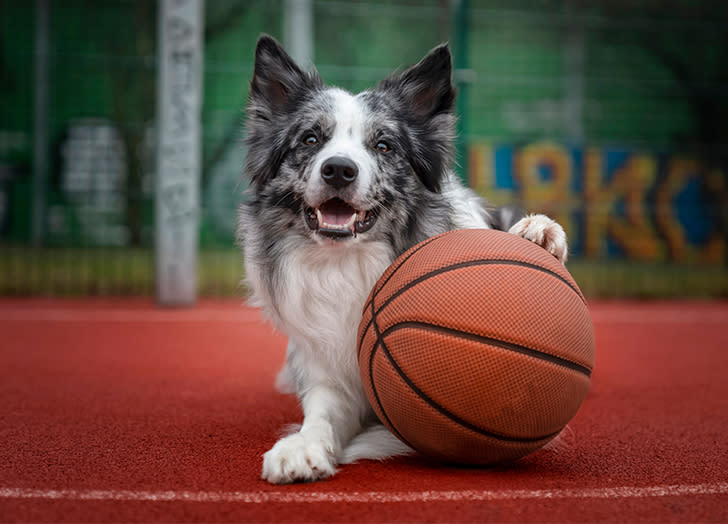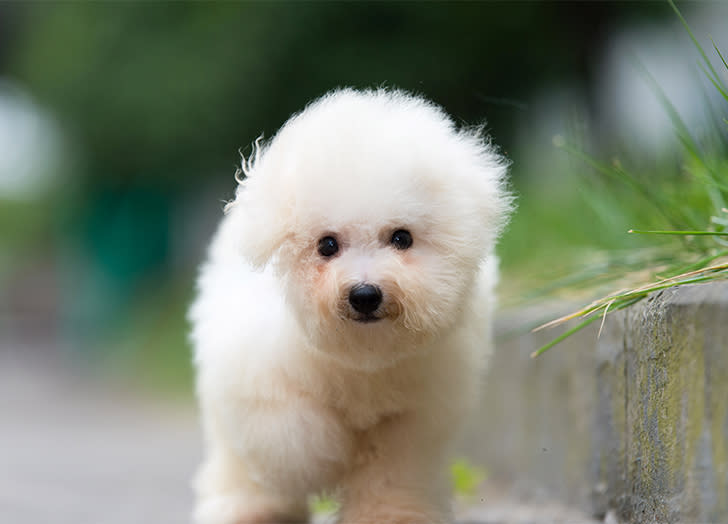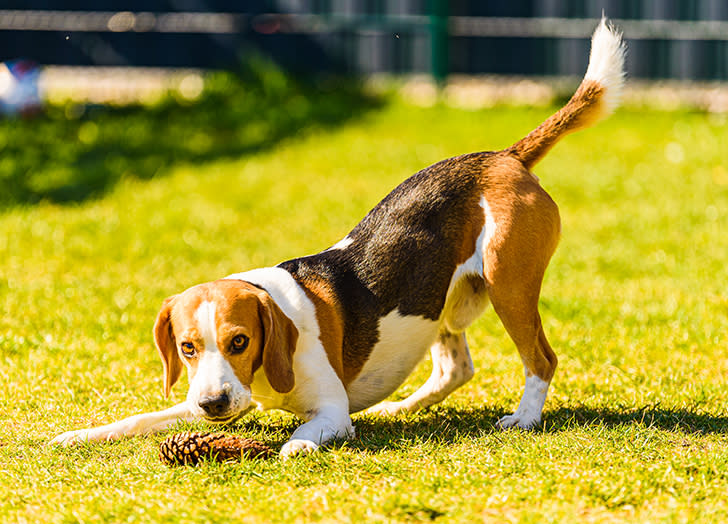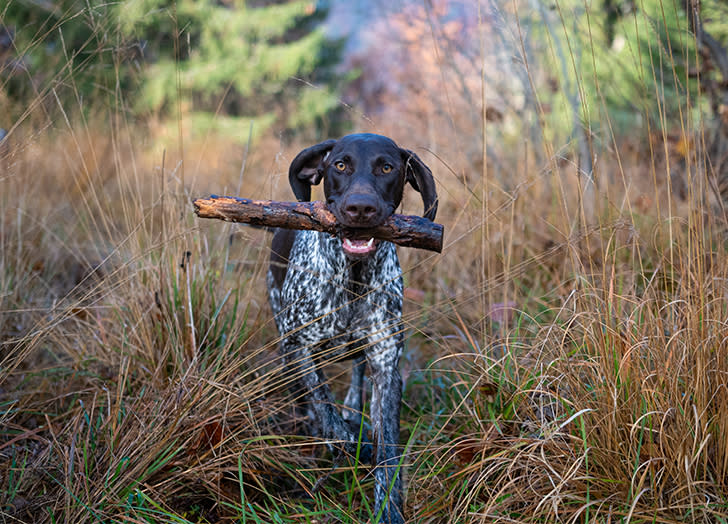22 of the Healthiest Dog Breeds on the Planet

Anyone who’s ever had to put a cone recovery collar on their dog knows that a sick pet is a huge bummer. The thing is, dogs are bound to need medical attention at some point in their lives. Everything from gum disease (very common in dogs) to myasthenia gravis (a rare nerve disorder) warrant a vet visit. Some breeds are genetically predisposed to develop certain issues over time and can pass those issues onto offspring. Other breeds are generally healthy and aren’t susceptible to any particular illnesses (or the chances they’ll develop a genetic disorder is so low it’s not worth worrying about). The healthiest dog breeds tend to fall into this second category. Many are high-energy small- or medium-sized pups. We can’t promise they’ll stay out of trouble, but if you’re looking for a healthy dog breed, start here.
Mixed breeds vs. purebred dogs
You may have heard rumors about purebred dogs being less healthy than mixed breed dogs. The reality is much more nuanced. A 2013 study examined the medical records of almost 30,000 dogs at a UC Davis vet clinic to see if there was any correlation between specific diseases and breed. Of 24 genetic disorders, only ten were more common purebred dogs. One, ruptured cranial cruciate ligament (a knee injury), was more common in mixed breed dogs. The remaining 16 genetic disorders (including hip dysplasia, epilepsy and some cancers) occurred just as often in both types of dogs.
Dr. Jerry Klein, CVO, writes on The American Kennel Club website that as a veterinarian and Afghan Hound breeder himself, he’s learned from experience that “pretty much any dog can get sick.” If your heart is set on a purebred dog, work with a responsible breeder. They screen both parents for potential genetic diseases to prevent litters from inheriting health problems. Many invest time and money into researching ways to eradicate known genetic abnormalities in their favorite breeds.
The healthiest dogs are well-fed, well-cared for and well-socialized, regardless of breed. Pups rely on their humans to not only provide nutrients that ward off disease, but to notice signs of pain or sickness. General health also doesn’t account for… accidents. Puppies of all breeds have been known to chip teeth, break bones and even eat their own poop.
Pro tip: Doing a dog DNA test for a mixed breed or rescue pup can give you lots of great insight into potential health issues you can watch out for as your dog ages.
Common health issues for large dog breeds
Big dogs and their big skeletons are more likely to develop joint issues over time. Crossroads Animal Hospital says both elbow and hip dysplasia are common in large breeds like German Shepherds and Great Danes. Based on data from the Orthopedic Foundation for Animals (OFA), many breeds on our list have low rankings of hip and elbow dysplasia. This means the joints are slightly misshapen and grind together. It often leads to arthritis and makes movement painful.
Bloat is another scary possibility for big dogs. When big dog breeds eat too quickly, they can swallow air that gets stuck in their chest cavities. The stomach expands, twists around itself and cuts off blood flow to the rest of the body. It’s life-threatening and can happen to any large breed, so keep your eyes peeled for excessive drooling or shortness of breath.
Common health issues for small dog breeds
Healthy Paws Pet Insurance says small breeds are at higher risk for ailments like patellar luxation and obesity. Patellar luxation is basically a bad kneecap that keeps moving out of place. Watch for limping or skipping in your tiny pup! Obesity is also an issue for small dogs because it’s much easier for them to become overweight. This can lead to serious complications like kidney failure.
The healthiest dog breeds
The dogs listed below are generally healthy. While almost all dogs run the risk of suffering from arthritis or blindness as they age, the ones on our list have very low-risk factors when it comes to genetic diseases. Remember, just because a dog carries a gene, doesn’t mean it’s a guarantee they’ll develop the corresponding disease! It’s always wise to ask your vet and the breeder what genetic testing is available for your dog’s breed.
Note: If a puppy comes from a reputable breeder, chances are the breeder has done all the hard work for you. Unless you’re planning on registering your dog with a club or breeding it, many health tests aren’t required. They could simply provide info - and the more you know, the earlier you can identify symptoms and give your dog the best treatment possible if they develop health issues.
RELATED: There’s a Really Cute Reason Why Dogs Follow You to The Bathroom

1. American Eskimo Dog
Height: 9-12 inches (toy), 12-15 inches (miniature), 15-19 inches (standard)
Weight: 6-10 pounds (toy), 10-20 pounds (miniature), 25-35 pounds (standard)
Personality: Lively, smart
Activity Level: High
Shedding Factor: Moderate to High
Life Expectancy: 13-15 years
American Eskimo Dogs come in three sizes and shed like the dickens. The American Eskimo Dog Club of America recommends puppies be screened for hip and eye issues once they turn 2 years old. The OFA advises watching for signs that an Eskie’s back legs aren’t working well. This could signal degenerative myelopathy or Legg-Calve-Perthes disease, both of which affect the back legs and hips.

2. American Foxhound
Height: 21-25 inches
Weight: 60-70 pounds
Temperament: Sweet, athletic
Activity Level: High
Shedding Factor: Moderate
Life Expectancy: 11-13 years
Bred to hunt foxes in Virginia, this American dog breed benefits from regular ear cleanings. Their floppy ears can trap dirt and debris, so avoid ear infections by keeping tabs on their ear health. Breeders will typically - and should - check for thrombocytopathy, a blood disorder Foxhounds may inherit that makes clotting difficult (though it’s more common in Basset Hounds and spitz-style dogs).

3. Australian Shepherd
Height: 18-23 inches
Weight: 40-65 pounds
Personality: Smart, athletic
Activity Level: High
Shedding Factor: Seasonal
Life Expectancy: 12-15 years
When they’re not running around in their favorite open space, this Australian dog breed can be found learning new tricks. One thing to ask a breeder is whether their Australian Shepherds have been screened for Collie Eye Anomaly. This genetic disease causes blindness. Watch for cataracts in old age, too!

4. Basenji
Height: 16-17 inches
Weight: 22-24 pounds
Personality: Independent, smart
Activity Level: High
Shedding Factor: Low
Life Expectancy: 13-14 years
About a quarter of the Basenjis evaluated by the OFA carry the gene for progressive retinal atrophy. According to the Basenji Club of America, this quiet, cat-like breed can also carry a gene for Fanconi Syndrome which is a kidney disease. The good news is if caught early, Fanconi Syndrome can be treated and almost cured.

5. Beagle
Height: 10-15 inches
Weight: 15-30 pounds
Personality: Friendly, doting
Activity Level: Moderate
Shedding Factor: Moderate
Life Expectancy: 10-15 years
The Beagle’s score in many OFA evaluations is terrific. Though Beagles have been known to be born with Musladin-Leuke Syndrome (MLS), a disease that affects their connective tissues and multiple systems, it’s very rare. To keep Beagles happy and healthy, surround them with family and other puppy friends.

6. Belgian Malinois
Height: 22-26 inches
Weight: 40-80 pounds
Personality: Smart, devoted, confident
Activity Level: High
Shedding Factor: Moderate
Life Expectancy: 14-16 years
Based on data from OFA and the American Belgian Malinois Club, aside from hip and elbow dysplasia common among dogs in general, this is a breed free from genetic disease. Yes, some Belgian Malinois will develop degenerative myelopathy over time, and some may lose eyesight. But overall, this is a hearty, healthy dog breed. I’ll have whatever Belgium is having!

7. Bichon Frise
Height: 9-12 inches
Weight: 12-18 pounds
Personality: Cheerful, adaptable
Activity Level: Low to Moderate
Shedding Factor: Hypoallergenic
Life Expectancy: 14-15 years
While these toy dogs don’t suffer the same joint problems as large breeds, more common ailments in Bichons are allergies and bladder infections. The OFA also recommends they have a vet do a patellar luxation evaluation during their annual vet visit to make sure your Bichon’s knees are in tip top shape.

8. Biewer Terrier
Height: 7-11 inches
Weight: 4-8 pounds
Personality: Smart, loving
Activity Level: Moderate
Shedding Factor: Low
Life Expectancy: 16 years
Like Bichons, Biewer Terriers may encounter some patellar luxation as they age. The American Kennel Club also notes Biewers could have sensitive stomachs. Otherwise, these are generally healthy, mellow little pups who love to play and be near you as much as possible.

9. Border Collie
Height: 18-22 inches
Weight: 30-55 pounds
Personality: Energetic, smart
Activity Level: High
Shedding Factor: Seasonal
Life Expectancy: 12-15 years
Even though they’re collies, it’s still rare for Border Collies to develop Collie Eye Anomaly (though it’s best to test for it anyway). The American Border Collie Association estimates less than 2.5 percent of Border Collies will suffer from CEA. With these dogs, focus on inventive ways to keep their minds and bodies active.

10. Cairn Terrier
Height: 9-10 inches
Weight: 13-14 inches
Personality: Curious, friendly
Activity Level: Moderate to High
Shedding Factor: Low to Moderate
Life Expectancy: 13-15 years
These small, spunky dogs rarely suffer from genetic diseases. To prevent any surprises down the road, the Cairn Terrier Club of America recommends testing any Cairns who haven’t already been screened by their breeder for Globoid-cell Leukodystrophy (GCL), a neurological disorder that is rare, but possible.

11. Chihuahua
Height: 5-8 inches
Weight: 6 pounds
Personality: Charming, independent
Activity Level: Moderate
Shedding Factor: Low
Life Expectancy: 14-16 years
As any Chihuahua owner will tell you, these tiny dogs run the show. They can also live a long time! If you want to help them out, have your vet do cardiac and eye exams regularly. Chihuahuas especially will try to sneak treats whenever they want—don’t let them get too overweight! This can put further strain on their already small legs.

12. Coton de Tulear
Height: 9-11 inches
Weight: 8-15 pounds
Personality: Charming, social
Activity Level: Moderate
Shedding Factor: Low to Moderate
Life Expectancy: 15-19 years
As with many small breeds, Cotons can live into their late teens. Be wary of their eye health. The OFA recommends testing for any eye issues early on to see if your Coton de Tulear carries a gene for canine multifocal retinopathy. This doesn’t always result in blindness, so the earlier you spot it the better.

13. English Foxhound
Height: 24 inches
Weight: 60-75 pounds
Personality: Social, affectionate
Activity Level: Moderate to High
Shedding Factor: Moderate
Life Expectancy: 10-13 years
Similar to the American Foxhound, the English Foxhound needs its ears cleaned regularly. Other than that, say hello to a very healthy breed whose only semi-common health issue is hip dysplasia. To keep these dogs spry, combine lots of outdoor exercise with relaxing, family-centered activities.

14. English Springer Spaniel
Height: 19-20 inches
Weight: 40-50 pounds
Personality: Dedicated, friendly
Activity Level: Moderate
Shedding Factor: Moderate
Life Expectancy: 12-14 years
Definitely keep tabs on your Springer Spaniel’s hips and elbows. They could develop joint problems later in life. Beyond that, those droopy ears will require frequent attention to—once again—prevent ear infections or build-up. More often than not, these are loving, healthy animals.

15. German Shorthaired Pointer
Height: 21-25 inches
Weight: 45-70 pounds
Personality: Friendly, active
Activity Level: High
Shedding Factor: Moderate
Life Expectancy: 10-12 years
The primary concern for new German Shorthair Pointer parents should be a cardiac exam for their puppy once it turns two years old. These are definitely healthy, active dogs who need rigorous daily exercise, so beware health scares that may pop up unexpectedly (like broken bones or cuts).

16. Greyhound
Height: 27-30 inches
Weight: 60-70 pounds
Personality: Independent, sweet
Activity Level: High
Shedding Factor: Low to Moderate
Life Expectancy: 10-13 years
Greyhounds, whether they’re sprinting around a field for exercise or being calm at home, have no pressing health concerns to speak of. Since they are large dogs, bloat should be on your radar. Very infrequently, young Greyhounds will suffer from Greyhound Polyneuropathy, a disorder that affects their movement (they do more of a bunny hop than a run).

17. Miniature Pinscher
Height: 10-12.5 inches
Weight: 8-10 pounds
Personality: Energetic, proud
Activity Level: High
Shedding Factor: Moderate to High
Life Expectancy: 12-16 years
Maybe Miniature Pinschers are so high and mighty because of their good health scores. As a toy breed, they should be screened for knee issues annually. Make sure your Miniature Pinscher breeder has tested your dog’s parents for Mucopolysaccharidoses (MPS) VI, a rare genetic disease that can cause abnormal growth.

18. Pharaoh Hound
Height: 21-25 inches
Weight: 45-55 pounds
Personality: Sweet, independent
Activity Level: Moderate to High
Shedding Factor: Moderate
Life Expectancy: 12-14 years
The Pharaoh Hound Club of America’s Health Chairman, Dr. Stephen Sipperly, says these pups aren’t “plagued with any significant disorders.” Testing for hypothyroidism is an option if you have reason to believe one or more of your dog’s parents suffered from it.

19. Pointer
Height: 23-28 inches
Weight: 45-75 pounds
Personality: Even-tempered, athletic
Activity Level: High
Shedding Factor: Moderate
Life Expectancy: 12-17 years
The American Pointer Club says Pointers are relatively healthy dogs who thrive in active households. Both Pharaoh Hound and Pointer parents will want to know how to spot potential thyroid issues in these dogs. If your Pointer suddenly becomes lethargic or doesn’t want to engage in activities, definitely hit up the vet. It’s not common, but it could be the culprit.

20. Shiba Inu
Height: 13.5-16.5 inches
Weight: 17-23 pounds
Temperament: Affectionate, protective
Activity Level: High
Shedding Factor: High
Life Expectancy: 13-16 years
Shiba Inus don’t have any crazy genetic conditions to fear, though they may suffer from allergies (manifesting in itchy skin). If you find this is the case with your Shiba (you can usually tell by about 6 months old), talk to your vet about allergy-friendly diets and products that will keep skin hydrated and free from irritants.

21. Siberian Husky
Average Height: 20-24 inches
Average Weight: 35-60 pounds
Temperament: Loyal, energetic
Activity Level: High
Shedding Factor: High
Life Expectancy: 12-14 years
Beyond standard eye exams and evaluating whether or not a Siberian Husky is developing hip dysplasia, these dogs are healthy and sturdy animals. Don’t let their energy become destructive! Provide plenty of outdoor time (they do well in cold weather, since they’re from Siberia) and doggy playmates.

22. Smooth Fox Terrier
Height: 15-16 inches
Weight: 15-18 pounds
Personality: Bold, friendly
Activity Level: High
Shedding Factor: Moderate
Life Expectancy: 12-15 years
The OFA really only recommends testing Smooth Fox Terriers for heart diseases and potential knee issues. Beyond that, these lively dogs just need annual vet visits and good dental hygiene to keep them feeling their best.
RELATED: 20 Toy Dog Breeds That Prove Big Things Come in Small Packages

